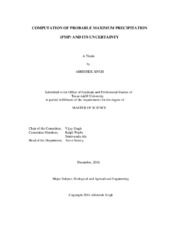| dc.description.abstract | Probable Maximum Precipitation (PMP) is used for estimating Probable Maximum Flood (PMF) which, in turn, is used for design of major hydraulic structures, such as dams and spillways, flood protection works, and nuclear power plants. One of the commonly used methods for estimating PMP is the statistical method that entails computation of frequency factor, adjustment of the frequency factor, construction of an enveloping curve of the frequency factor, estimation of PMP, choosing a probability distribution, and determination of the return period. This study determined the PMP values for different durations using data from the Brazos River basin, Texas. There are, however, uncertainties associated with the PMP values estimated using the statistical method. It was found that significant uncertainty in the PMP estimates can occur from the use of enveloping curve of the frequency factor, and uncertainty in sample mean and sample standard deviation. Hershfield’s curve yielded higher PMP estimates, therefore, a basin specific-enveloping curve is suggested. The return period of a PMP value was obtained from frequency analysis. From 24 commonly used statistical distributions, 5 goodness of fit tests and the use of hazard rate, the Burr XII distribution was found to be the best frequency distribution. It was observed that the return period was not significantly higher than that obtained from the hydrometeorological reports (HMRs) of National Weather Service and other studies. For quantifying uncertainty, design risk estimates along with probability bounds on the PMP values were determined. The relative contribution of each random variable to the total uncertainty was also determined. Then, risk analysis of extreme precipitation was also done to assess the damage a PMP event can cause. The damage due to a single PMP event of 12-hour duration can be as high as 2 billion U.S. dollars in Harris County, Texas. | en |


